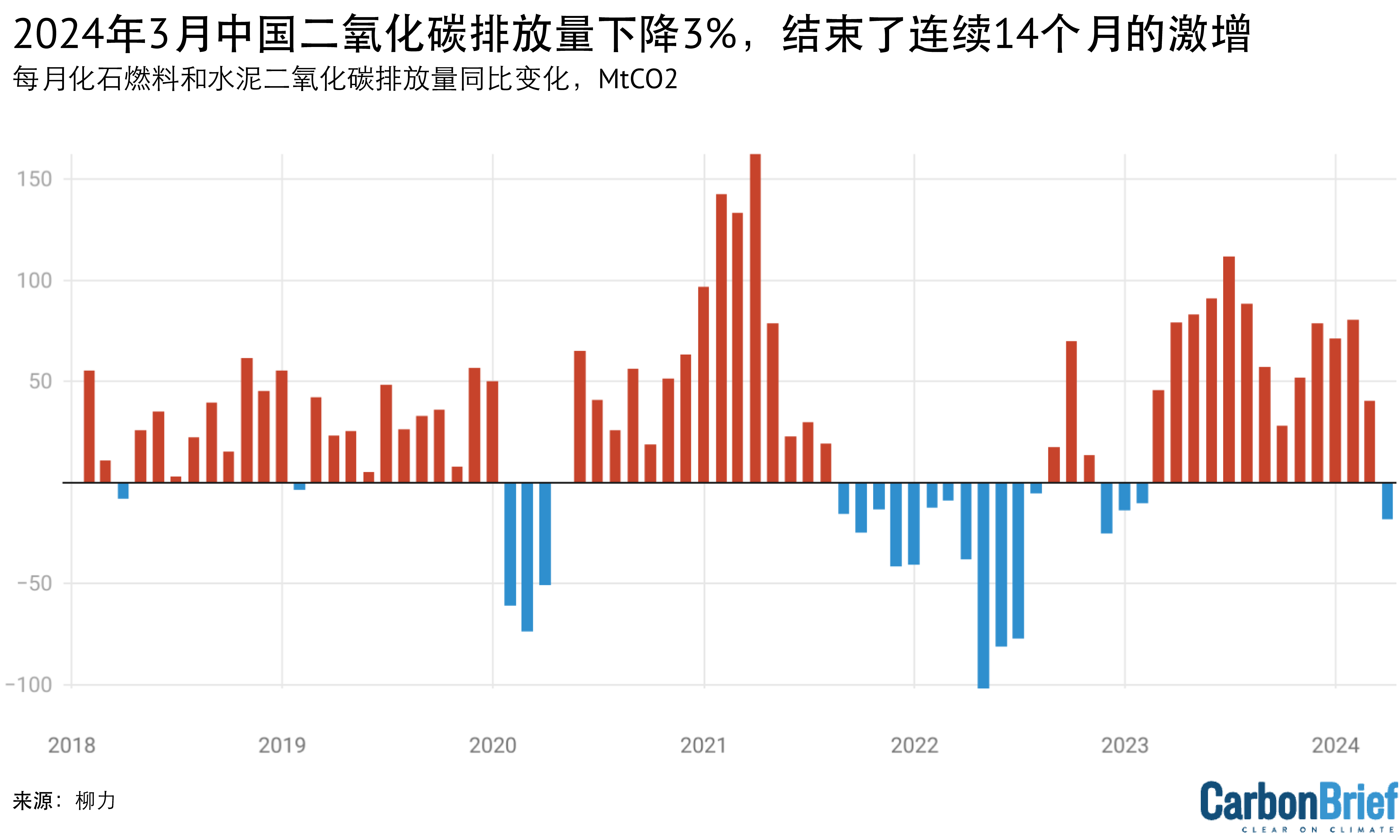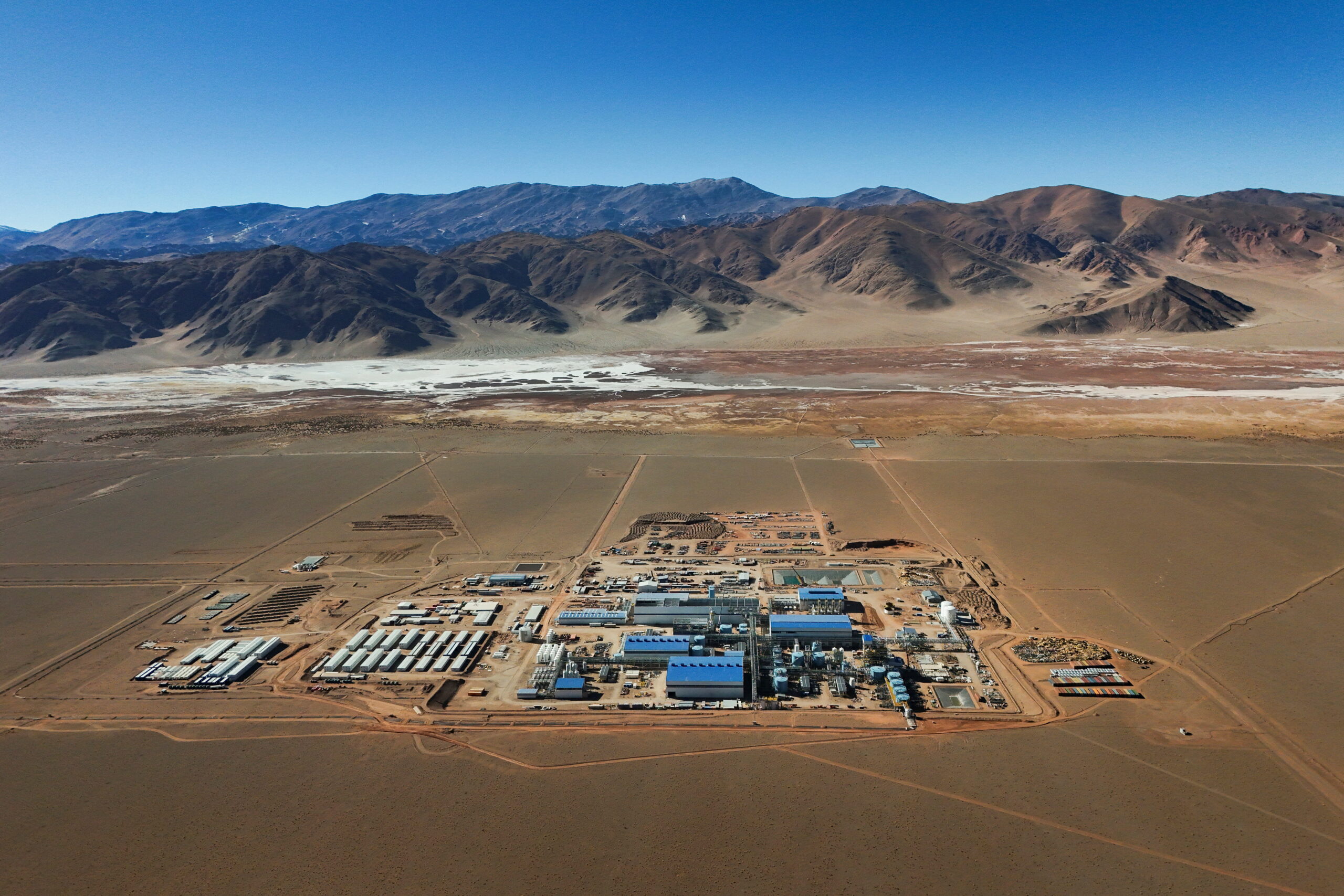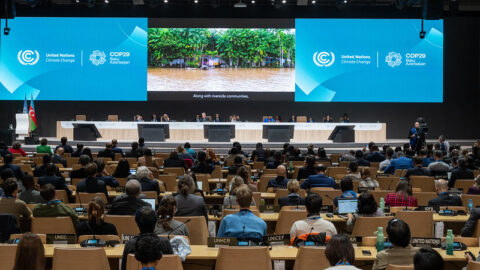2024年3月,中国的二氧化碳(CO2)排放量下降了3%。这标志着自2022年12月放宽防疫措施、重启经济活动以来,中国碳排放量连续14个月的增长告一段落。
Carbon Brief基于官方数字和商业数据进行的新分析显示,中国CO2排放量在2023年或已达峰。
2024年3月CO2排放量下降的驱动因素包括光电和风电的快速增长,这满足了电力需求增长的90%,以及建筑活动的减少。
石油需求增长也陷入停滞,表明疫情后的经济反弹可能已临近尾声。
如果中国能维持去年创纪录的清洁能源建设水平,该国有望在2023年实现碳达峰。
然而,整个行业和政府对清洁能源的增长前景看法不一。如果中国尚未实现碳达峰,如何弥合分歧将是决定碳达峰何时到来的关键因素。
该分析的其他关键发现包括:
- 尽管电力需求强劲增长,但光电和风电的增长推动化石燃料发电量份额从前一年的67.4%下降至2024年3月的63.6%。
- 由于中国房地产建设活动的持续萎缩,2024年3月钢铁产量下降了8%,水泥产量下降了22%。
- 电动汽车现在约占中国道路上汽车总量的十分之一,将汽油需求增长拉低了约3.5个百分点。
- 去年创纪录的太阳能新增发电装机中,约45%是规模较小的分布式光伏,导致看似出现了“数据缺失”问题。
为什么三月排放量出现下降?
根据中国国家统计局发布的初步能源消费数据,2024年第一季度中国的碳排放量总体显著增加。

今年1月和2月的碳排放量仍较2023年的低基数大幅增长,彼时中国经济仍因刚结束不久的清零防疫措施而受到抑制。
因此,与2023年同期相比,2024年第一季度的CO2排放量同比增长了3.8%,煤炭消费量增长了3%,石油消费量增长了4%,天然气消费量增长了11%。
转折点出现在今年3月份。由于该月份的煤炭消费量降低了1%,石油消费保持平稳,而水泥产量则下降了22%,导致3月CO2排放量同比下降了3%。尽管天然气消费量增长了14%,但由于其在中国能源结构中占比较小,从而影响有限。
如下图所示,自2022年12月放宽疫情限制措施后,中国的碳排放量从2023年2月开始回升。
因此,2023年1月至2月的同比比较仍然受到去年疫情导致的低基数影响,这使得3月的数据成为能够清楚地反映碳排放趋势的首个月度数据。

近年来,中国碳排放量增长的主要推动力来自电力部门(见下文)。
反之,3月碳排放趋势转为下降,主要原因也是电力部门的排放量增长的大幅放缓。由于光电和风电的强劲增长,电力部门3月的碳排放量仅同比增长了1%。
如下图所示,尽管电力部门的排放量企稳,但建筑业对钢铁和水泥的需求持续下降,这才是3月份碳排放量减少的最主要原因。
钢铁产量下降了8%,因此炼钢厂的主要燃料炼焦煤的产量也随之降低。水泥产量同比骤降了22%。
由于政府对房地产行业高杠杆的打击和对金融风险的管控,以及建筑行业过去的繁荣导致了产能过剩,房地产行业投资已连续第三年收缩,这使得上述排放趋势可能会继续维持。

尽管建筑业需求出现收缩,但中国对钢铁和其他能源密集型金属的需求并未出现预期的大幅下降。
这背后的原因是制造业的快速增长和对该行业的投资,而在设施建设和工业机械生产中都需使用金属制品。
但是,随着全球各种商品和大宗货物的市场逐渐饱和,这种制造业的增长不太可能持续下去。当局的经济政策现在强调“新质生产力”,这是推动经济增长摆脱对传统重工业的依赖的最新尝试。“新质生产力”指高端的制造和研发,这些领域的能源密集程度大多比中国的传统工业部门更低。
从2024年3月其他行业的情况来看,运输用油的需求在经历了几个月的强劲增长之后,变得与去年同期相比近乎持平。这表明疫情后的需求反弹可能正在逐渐消失。
航空燃料(+35%)和汽油(+7%)产量仍在增长,说明客运需求出现增长。但柴油产量增长停滞(+1%),原油加工量也仅增加了1%。
电动汽车的增长正显著削减石油需求量。根据过去十年的累计销售数据估计,电动汽车在道路上所有车辆中的占比从去年的7.0%增加到10.5%。这表明,电动汽车的普及使汽油需求增长降低了3.5个百分点。
天然气需求出现大幅反弹,同比增长14%。此前天然气价格高企导致需求下降。天然气消费的增长主要来自工业和家庭部门。
随着燃气电厂利用率有所恢复,电力部门的天然气消费量增长了8%,但这仅占总体增长很小的一部分。
天然气在中国能源结构中的占比曾连续增长了二十多年,在2021至2023年间有所下降,现在开始恢复增长。
近期推动碳排放量增长的一个因素仍在继续:化工行业的煤炭消费量增长了14%,延续了2022和2023年两位数的增长趋势。
尽管目前还没有足够的数据来估算4月份的CO2排放量,但当月的工业数据表明,3月排放下降的趋势仍在继续。
由于光伏发电满足了大部分的电力需求增长,火力发电量——主要来自煤电——缓慢增长了1.3%。钢铁、水泥和焦炭产量分别下降了8%、9%和7%,反映出建筑需求的持续减少。炼油量下降了3%。
国内煤炭开采量下降了3%,而进口量增加了11%,这意味着总供应量减少了5%。
天然气需求进一步强劲增长,进口量增长了15%,国内产量增加了3%。在能源密集型行业中,化工和有色金属行业的产量继续保持较快增长。
光电和风电满足需求增长
企稳的电力部门排放量值得关注,因为电力需求继续以7.4%高速增长,而受长期干旱的影响,水电利用率低于长期平均水平。
过去几年,工业用电推动电力需求迅速增长。3月,工业需求增长放缓,但服务业的反弹维持了整体需求的增长。
近一半的用电需求增长来自工业,其中有色金属、化工、机械和电子等行业是最主要的需求增长的领域。服务业贡献了需求增长的三分之一,主要源自批发和零售贸易,另有六分之一来自家庭用电。
在2022年历史性的热浪引发一波空调购买潮的推动下,家庭用电需求在过去几年也出现了激增,尤其是在以前没有空调的低收入家庭。
尽管电力需求快速增长,但由于分布式光伏电站的大规模部署,规模以上工业发电量增速放缓至3%。
(与大型集中式太阳能发电场相比,分布式光伏电站指的是装机规模较小的发电系统,通常安装在家庭和企业的屋顶上。)
总体而言,由于2023年光电和风电装机的创纪录增长,光电和风电发电量占比已达到22%,并在3月实现了近90%的同比增长。非化石燃料发电量占比从去年的32.6%上升至36.2%。

分布式光伏对发电的贡献越来越大,但这在一定程度上被中国月度电力数据的报告方式所掩盖。国家统计局只发布大型光伏和风力发电站的月度发电量。它还系统性地上修了前几年的数据,这表明其没有实时捕捉新进入市场的企业的发电量。
由于去年创纪录的光伏新增装机容量中有45%是分布式发电,对小型光伏装机的排除对这些数字的影响比以往大得多。
这在中国和海外引起很多困惑,特别是报告的用电量数据远大于发电量数据,这显然是不可能的,彭博社甚至称其为“数据缺失问题”。
然而,用电量和规模以上工业发电量之间不断扩大的差距表明,分布式光伏在满足用电需求方面的贡献越来越大。
与月报数据不同,中国的年度统计公报中没有“缺失”的数据,因为年度统计包括所有电厂,无论其规模。例如,2023年的年度统计公报显示,光伏发电量是月度统计的两倍,风电发电量则多出了10%。
事实上,如果按照月度数据中的装机容量和利用小时数来计算发电量,得到的数据与年度报告数据非常接近。这清楚地表明,尽管统计局的月度数据中没有纳入分布式光伏的发电量,但其的确为满足电力需求做出重大贡献。
清洁能源热潮继续
去年光电和风电新增发电装机容量约300吉瓦(GW),这推动了3月份碳排放量的下降。这种热潮在2024年前三个月加速,与去年相比增长了40%。
太阳能发电新增装机容量46吉瓦,同比增长36%;风电新增装机容量16吉瓦,同比增长50%。
通常来说,第一季度的新增装机容量增速一般较低,而且由于报告滞后,相当多的新增装机在年底才被报告。
强劲的同比增长表明,对新项目能否成功并网的担忧并未影响新增装机容量增加的步伐。即便今年剩下时间里增速会有所放缓,但迄今为止的数据表明,去年创纪录的增速可能会在2024年持续。
今年1月至3月,太阳能电池板产量在去年的高基数上又增长了20%,表明中国和海外的需求强劲。
电动汽车产量增长了29%,汽车总产量恢复了下降趋势,这使得电动汽车占比持续快速攀升,在第一季度达到了31%,而去年同期为26%。
由于光电和风电项目的经济效益显著,对新增装机的主要限制来自并网。因担心无法消纳新增发电量,去年多个省级电网运营商已开始限制新增光电和风电项目。
这凸显了中国电网运营上的短板,因为风电和光电占中国总发电量的份额仍然有限,仅为15%。相比之下,两者在欧盟电力系统中的占比为27%,德国、西班牙和希腊达到40%。
中国已开始采取行动解决该问题。国家发改委已开始放宽光电和风电并网的要求。这将增加风光项目投资者的不确定性,但提高了电网运营商的消纳能力,从而支持发电装机和发电量的增长。
国家发改委还发布了一项推动储能发展的政策,承诺到2027年,电力系统将能够支撑新增风光装机容量,同时将因电网问题而浪费的发电量比例保持在较低水平。
虽然光电和风电已开始满足大部分或全部用电需求的增长,但煤电投资仍在继续。第一季度,火电装机的新增速度同比略有放缓,但各省2024年的“重点项目清单”中包括超过200吉瓦的火电项目,其主要是燃煤电厂。
未来仍充满变数
中国3月份碳排放量的下降可能标志着自2020年以来碳排放的强劲增长出现了转折点。正如 Carbon Brief 去年秋天发布的一篇分析所述,目前清洁能源的增长率有可能使该国提前实现碳达峰。
因此,清洁能源增长是否会持续,是影响中国未来排放路径的关键问题。但是,外界对于未来风电和光电的发展速度仍存在很大分歧。
中国光伏行业协会在其“保守”情景中预测,2024年至2030年间年均新增装机容量为225吉瓦,比2023年的217吉瓦略有增加。在“乐观”情景下,这一数字将加速至每年280吉瓦。根据该协会预测,中国的太阳能总装机容量将从目前的660吉瓦,到2030年增加到2200至2600吉瓦。
据风电行业数据,要实现2060年碳中和目标,中国需要在2021年至2025年间每年新增超过50吉瓦的风电装机。从2026年起,每年新增装机超过60吉瓦。这是一个相对适中的轨迹,因为2023年风电新增装机容量已经达到76吉瓦。
另一方面,国家能源局局长章建华在最近一篇文章中写道,清洁能源的新增装机容量应保持在每年100吉瓦以上,但这不到2023年实际水平的一半。这意味着他认为最近的加速增长是反常的,可能难以持续。
与之类似,在国家能源局2024年的工作计划中,从总发电装机容量和非化石能源发电容量占比,可以推算出非化石能源新增装机的目标在170吉瓦左右。(尽管2023年工作计划的目标是160吉瓦,但实际新增接近300吉瓦。)
下图展现了对于光电和风电发展的不同愿景。深蓝色线代表了章建华的预期,即年新增装机容量将回落到2020年至2022年水平;浅蓝色和红色线是可再生能源行业预测的增长趋势,其大致保持在2023年的水平,或稳步增长。

到2030年,光伏行业协会和国家能源局就光电和风电的装机目标差距为1400至1800吉瓦。如果新增的清洁能源发电量在2030年能够取代煤电,那么碳排放量将比当前水平下降10至15%。到2035年,随着风电和光电进一步发展,碳排放量将比当前水平下降20至25%。
章建华在文章中指出了一些挑战,以解释为何他认为清洁能源新增发电容量水平较低,包括储能价格机制尚未健全,能源转型政策合力亟待加强,以及集中连片新能源发展用地、用海空间不足等。
尽管如此,减缓光电、风电和相关储能的新增装机速度将给中国经济泼上一盆冷水,因为这些清洁能源行业已成为经济增长的一个关键来源。
此外,最近对这些行业生产能力的大量投资,只有在清洁能源设备需求持续增长的情况下才能得到利用和回报。
政府雄心的减弱也反映在今年设定的较为保守的官方目标上。根据环保部最近设定的目标,2024年碳强度(每单位GDP的排放量)的目标降幅为3.9%。
尽管这一目标超过过去三年碳强度年均仅下降1.5%的水平,但考虑到GDP增速目标是“约5%”,该碳强度目标实际将允许碳排放量增长逾1%。
在2021年至2023年碳排放量快速增加之后,中国已经严重偏离了2025年和2030年的碳强度目标,而2024年的年度目标未能缩小这一差距。
3.9%正是实现“十四五”规划中碳排放强度下降18%的目标所需的年均下降幅度。因此,该目标避免了落后幅度进一步扩大,但对弥补迄今为止的进展滞后毫无作用。
国家发改委还设定了一个相对保守的目标,即到2024年将“化石能源强度”降低2.5%,这将允许碳排放量增加2%以上。
章建华还认为,在2026至2030年期间,清洁能源应满足70%的能源消费增长,这一目标也与清洁能源新增装机容量放缓的趋势一致。
这意味着,能源消费增长的30%仍将通过增加化石燃料的使用来满足,因此CO2排放量也将继续增加。
持续增长的碳排放量意味着中国将面临无法实现2030年的碳强度承诺的风险,而这是中国在《巴黎协定》下提交的国际气候承诺的一部分。因为假设GDP年均增长5%或更低,根据这一承诺,从2023年到2030年,能源部门的CO2排放量没有增加的空间。
因此,中国能否实现其气候承诺,取决于清洁能源增长是否会继续显著超过中央政府制定的目标,亦或是这些目标在未来是否会提高。
数据来源
本分析数据来源于中国国家统计局、国家能源局、中国电力企业联合会、中国海关官方发布的数据以及行业数据提供商WIND资讯。
电力行业煤炭消费量是根据煤炭发电量和燃煤电厂每月平均发热量来估算的,以避免官方煤炭消费量影响近期数据的问题。煤炭发电量根据火力发电总量和燃煤、燃气、生物质电厂报告容量和利用小时数计算,以得到综合火力发电数据。
当数据来自多个来源时,本文交叉引用不同来源并尽可能使用官方来源,调整总消费数控,以匹配国家统计局报告的消费增长和能源结构变化。
2024年第一季度的数据进行了调整,以匹配国家统计局初步官方数据中报告的整个季度的同比增长率。但无论有没有这种调整,三月份排放量下降的结论都成立。
二氧化碳排放量估算基于国家统计局默认的 2018 年燃料热值和中国最新国家温室气体排放清单中的排放因素。水泥二氧化碳排放基于截至 2023 年的年度估算。
对于石油消耗量,表观消耗量是根据炼油厂吞吐量计算,减去石油产品的净出口量。
The post 分析:月度碳排放量下降或表明中国已在2023年碳达峰 appeared first on Carbon Brief.
Climate Change
Efforts to green lithium extraction face scrutiny over water use
Mining companies are showcasing new technologies which they say could extract more lithium – a key ingredient for electric vehicle (EV) batteries – from South America’s vast, dry salt flats with lower environmental impacts.
But environmentalists question whether the expensive technology is ready to be rolled out at scale, while scientists warn it could worsen the depletion of scarce freshwater resources in the region and say more research is needed.
The “lithium triangle” – an area spanning Argentina, Bolivia and Chile – holds more than half of the world’s known lithium reserves. Here, lithium is found in salty brine beneath the region’s salt flats, which are among some of the driest places on Earth.
Lithium mining in the region has soared, driven by booming demand to manufacture batteries for EVs and large-scale energy storage.
Mining companies drill into the flats and pump the mineral-rich brine to the surface, where it is left under the sun in giant evaporation pools for 18 months until the lithium is concentrated enough to be extracted.
The technique is relatively cheap but requires vast amounts of land and water. More than 90% of the brine’s original water content is lost to evaporation and freshwater is needed at different stages of the process.
One study suggested that the Atacama Salt Flat in Chile is sinking by up to 2 centimetres a year because lithium-rich brine is being pumped at a faster rate than aquifers are being recharged.
Lithium extraction in the region has led to repeated conflicts with local communities, who fear the impact of the industry on local water supplies and the region’s fragile ecosystem.
The lithium industry’s answer is direct lithium extraction (DLE), a group of technologies that selectively extracts the silvery metal from brine without the need for vast open-air evaporation ponds. DLE, it argues, can reduce both land and water use.
Direct lithium extraction investment is growing
The technology is gaining considerable attention from mining companies, investors and governments as a way to reduce the industry’s environmental impacts while recovering more lithium from brine.
DLE investment is expected to grow at twice the pace of the lithium market at large, according to research firm IDTechX.
There are around a dozen DLE projects at different stages of development across South America. The Chilean government has made it a central pillar of its latest National Lithium Strategy, mandating its use in new mining projects.
Last year, French company Eramet opened Centenario Ratones in northern Argentina, the first plant in the world to attempt to extract lithium solely using DLE.
Eramet’s lithium extraction plant is widely seen as a major test of the technology. “Everyone is on the edge of their seats to see how this progresses,” said Federico Gay, a lithium analyst at Benchmark Mineral Intelligence. “If they prove to be successful, I’m sure more capital will venture into the DLE space,” he said.
More than 70 different technologies are classified as DLE. Brine is still extracted from the salt flats but is separated from the lithium using chemical compounds or sieve-like membranes before being reinjected underground.
DLE techniques have been used commercially since 1996, but only as part of a hybrid model still involving evaporation pools. Of the four plants in production making partial use of DLE, one is in Argentina and three are in China.
Reduced environmental footprint
New-generation DLE technologies have been hailed as “potentially game-changing” for addressing some of the issues of traditional brine extraction.
“DLE could potentially have a transformative impact on lithium production,” the International Lithium Association found in a recent report on the technology.
Firstly, there is no need for evaporation pools – some of which cover an area equivalent to the size of 3,000 football pitches.
“The land impact is minimal, compared to evaporation where it’s huge,” said Gay.


The process is also significantly quicker and increases lithium recovery. Roughly half of the lithium is lost during evaporation, whereas DLE can recover more than 90% of the metal in the brine.
In addition, the brine can be reinjected into the salt flats, although this is a complicated process that needs to be carefully handled to avoid damaging their hydrological balance.
However, Gay said the commissioning of a DLE plant is currently several times more expensive than a traditional lithium brine extraction plant.
“In theory it works, but in practice we only have a few examples,” Gay said. “Most of these companies are promising to break the cost curve and ramp up indefinitely. I think in the next two years it’s time to actually fulfill some of those promises.”
Freshwater concerns
However, concerns over the use of freshwater persist.
Although DLE doesn’t require the evaporation of brine water, it often needs more freshwater to clean or cool equipment.
A 2023 study published in the journal Nature reviewed 57 articles on DLE that analysed freshwater consumption. A quarter of the articles reported significantly higher use of freshwater than conventional lithium brine mining – more than 10 times higher in some cases.
“These volumes of freshwater are not available in the vicinity of [salt flats] and would even pose problems around less-arid geothermal resources,” the study found.
The company tracking energy transition minerals back to the mines
Dan Corkran, a hydrologist at the University of Massachusetts, recently published research showing that the pumping of freshwater from the salt flats had a much higher impact on local wetland ecosystems than the pumping of salty brine. “The two cannot be considered equivalent in a water footprint calculation,” he said, explaining that doing so would “obscure the true impact” of lithium extraction.
Newer DLE processes are “claiming to require little-to-no freshwater”, he added, but the impact of these technologies is yet to be thoroughly analysed.
Dried-up rivers
Last week, Indigenous communities from across South America held a summit to discuss their concerns over ongoing lithium extraction.
The meeting, organised by the Andean Wetlands Alliance, coincided with the 14th International Lithium Seminar, which brought together industry players and politicians from Argentina and beyond.
Indigenous representatives visited the nearby Hombre Muerto Salt Flat, which has borne the brunt of nearly three decades of lithium extraction. Today, a lithium plant there uses a hybrid approach including DLE and evaporation pools.
Local people say the river “dried up” in the years after the mine opened. Corkran’s study linked a 90% reduction in wetland vegetation to the lithium’s plant freshwater extraction.
Pia Marchegiani, of Argentine environmental NGO FARN, said that while DLE is being promoted by companies as a “better” technique for extraction, freshwater use remained unclear. “There are many open questions,” she said.
AI and satellite data help researchers map world’s transition minerals rush
Stronger regulations
Analysts speaking to Climate Home News have also questioned the commercial readiness of the technology.
Eramet was forced to downgrade its production projections at its DLE plant earlier this year, blaming the late commissioning of a crucial component.
Climate Home News asked Eramet for the water footprint of its DLE plant and whether its calculations excluded brine, but it did not respond.
For Eduardo Gigante, an Argentina-based lithium consultant, DLE is a “very promising technology”. But beyond the hype, it is not yet ready for large-scale deployment, he said.
Strong regulations are needed to ensure that the environmental impact of the lithium rush is taken seriously, Gigante added.
In Argentina alone, there are currently 38 proposals for new lithium mines. At least two-thirds are expected to use DLE. “If you extract a lot of water without control, this is a problem,” said Gigante. “You need strong regulations, a strong government in order to control this.”
The post Efforts to green lithium extraction face scrutiny over water use appeared first on Climate Home News.
Efforts to green lithium extraction face scrutiny over water use
Climate Change
Maryland’s Conowingo Dam Settlement Reasserts State’s Clean Water Act Authority but Revives Dredging Debate
The new agreement commits $340 million in environmental investments tied to the Conowingo Dam’s long-term operation, setting an example of successful citizen advocacy.
Maryland this month finalized a $340 million deal with Constellation Energy to relicense the Conowingo Dam in Cecil County, ending years of litigation and regulatory uncertainty. The agreement restores the state’s authority to enforce water quality standards under the Clean Water Act and sets a possible precedent for dozens of hydroelectric relicensing cases nationwide expected in coming years.
Climate Change
A Michigan Town Hopes to Stop a Data Center With a 2026 Ballot Initiative
Local officials see millions of dollars in tax revenue, but more than 950 residents who signed ballot petitions fear endless noise, pollution and higher electric rates.
This is the second of three articles about Michigan communities organizing to stop the construction of energy-intensive computing facilities.
A Michigan Town Hopes to Stop a Data Center With a 2026 Ballot Initiative
-
Climate Change2 years ago
Spanish-language misinformation on renewable energy spreads online, report shows
-
Climate Change2 months ago
Guest post: Why China is still building new coal – and when it might stop
-
Climate Change Videos2 years ago
The toxic gas flares fuelling Nigeria’s climate change – BBC News
-

 Greenhouse Gases1 year ago
Greenhouse Gases1 year ago嘉宾来稿:满足中国增长的用电需求 光伏加储能“比新建煤电更实惠”
-
Greenhouse Gases2 months ago
Guest post: Why China is still building new coal – and when it might stop
-

 Climate Change1 year ago
Climate Change1 year ago嘉宾来稿:满足中国增长的用电需求 光伏加储能“比新建煤电更实惠”
-

 Carbon Footprint2 years ago
Carbon Footprint2 years agoUS SEC’s Climate Disclosure Rules Spur Renewed Interest in Carbon Credits
-
Renewable Energy3 months ago
US Grid Strain, Possible Allete Sale









